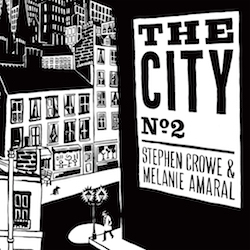Thursday Comics Hangover: You belong to The City
Why are fictional cities such a common trope in comics? More than any other art form, comics seem to make it easy to create locations with their own unique spirit. Compare Metropolis in the Superman comics with the Metropolis of any of the Superman movies, for instance, and you'll see how hard it is for film to duplicate the world-building of the comic books. In just a few panels, artists can give Metropolis its own flavor: an art deco city of the future, with flags and golden sunlight everywhere.

In the second issue of a comic titled The City, Seattle cartoonists Stephen Crowe and Melanie Amaral are hard at work creating a fictional city of their own. Set somewhere in Europe, and sometime between World War I and World War II, the titular city is going through that awkward civilizational phase. It's old enough to have a monarchy, for instance, but modern enough to not know what to do with a king. The first story in The City 2 is about a king returning after a long absence, only to find his grand return foiled by moronic bureaucrats. "The King's coming tomorrow," a border guard tells the king's assistant in front of the king, "We got a memorandum about it. It's going to be a big show. We've got all the bunting in, haven't we?" "Oh, for heaven's sake," moans the king as a second guard shows off a box full of bunting for his arrival. It's a dry and funny story that wouldn't be out of place in a Monty Python sketch.
The City is made up of small vignettes which are related only by theme and setting. (You don't need to have read the first issue at all to enjoy the second issue.) Elsewhere in the city, a pair of academic revolutionaries quibble over the name of their new literary magazine. Elsewhere, some elites are anxious at the prospect of eating ethnic foods. In between the stories are advertisements for a grand hotel ("An impenetrable fortress of privilege in the heart of the city," the ad swoons) and other gorgeous artistic flourishes.
The artwork here is beautiful, recalling the whimsy of Kate Beaton and the elegance of old New Yorker cartoons. The dialogue is appropriately stuffy, with pompous characters setting the stage for their own comeuppance. The biggest complaint I have with The City is relatively small - the lettering in one story at the end of the issue is sloppy and difficult to read. In contrast with the delicate lettering in the rest of the issue, those airy balloons and ugly cursive captions feel more amateurish than everything else.
But fans of literary comedy will be over the moon while reading The City 2. You'll find elements of Kafka and Stefan Zweig throughout. Amaral and Crowe expertly capture that sensation of the time in Europe in between World Wars, when civilization was barely containing the bestial angst just beneath the surface. Sure, people dress in fancy clothes and speak with the utmost politeness, but you expect that at any moment all the finery and shiny medals might disappear in a whirlwind of chaos. There's not much difference between an upright citizen and a cornered animal - just a uniform or a fancy dress is all that's holding us together.